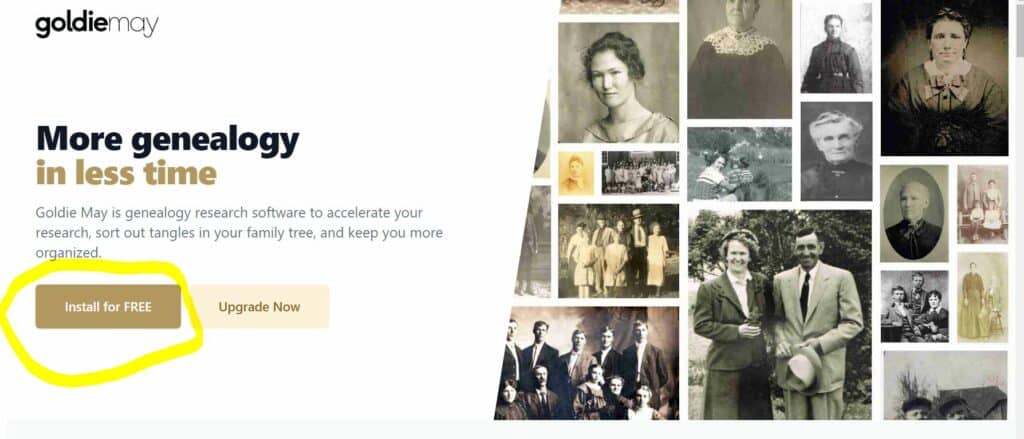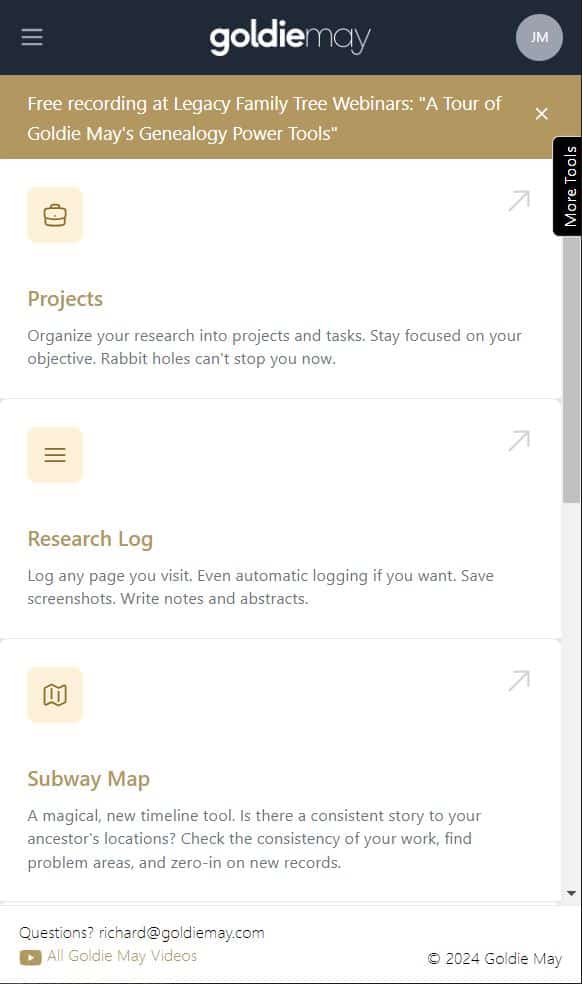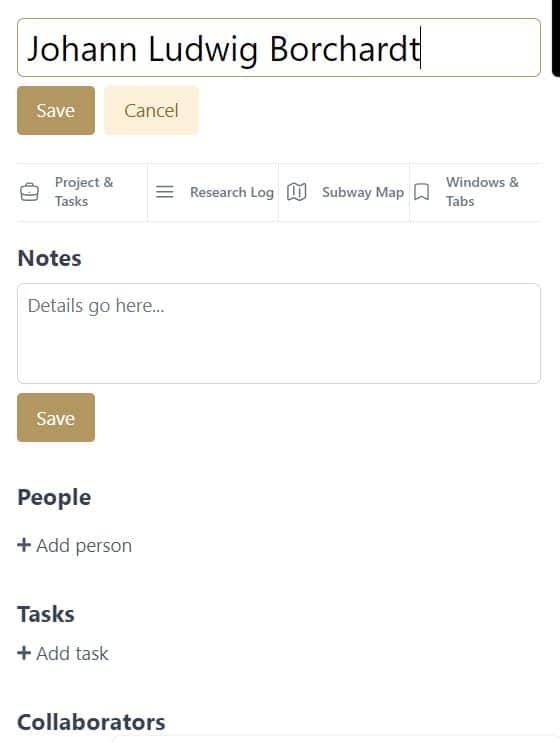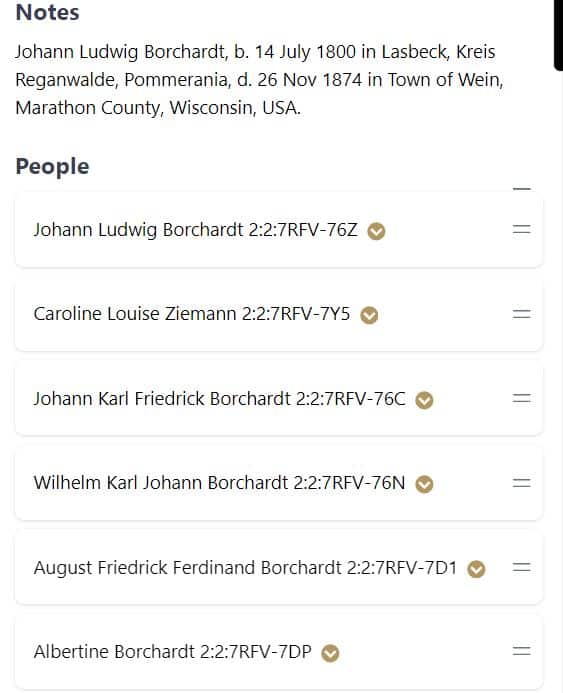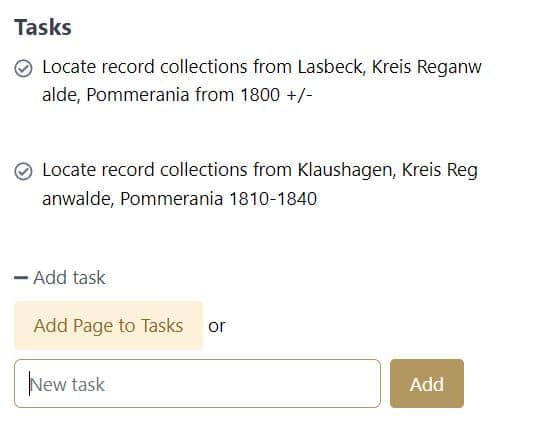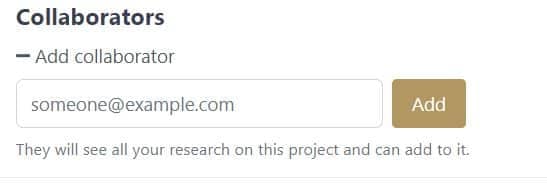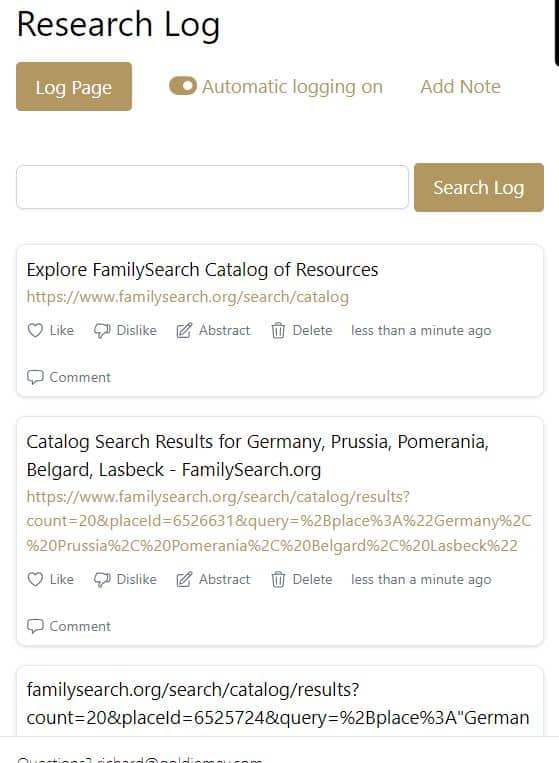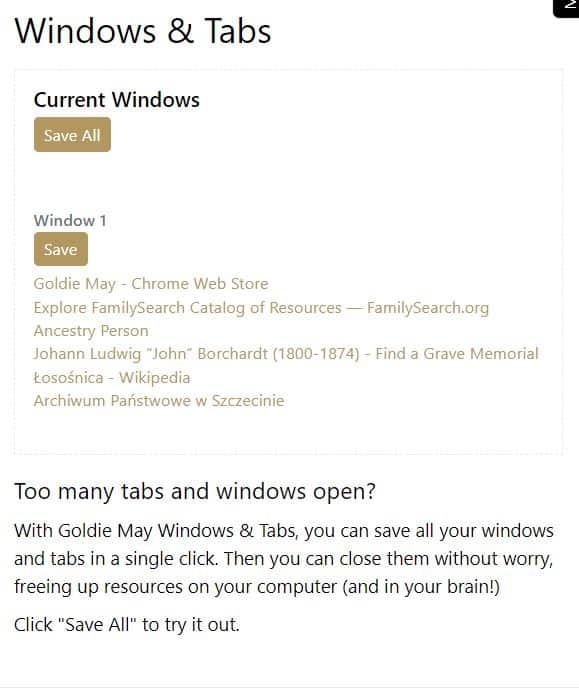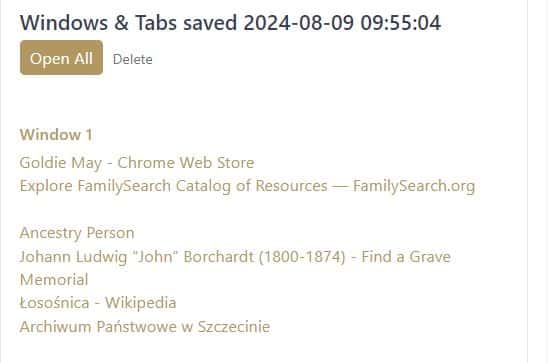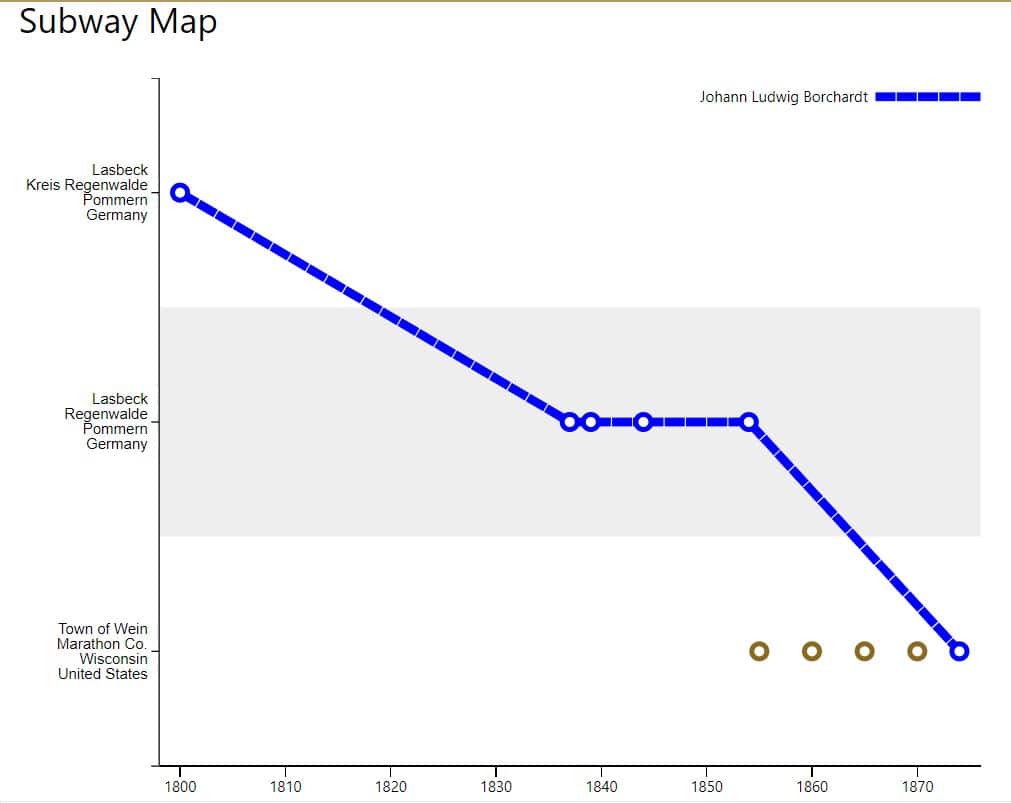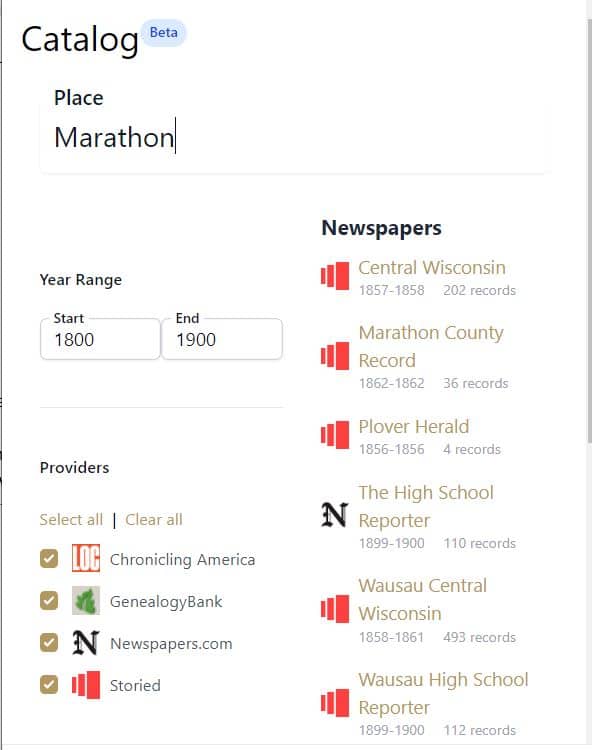You’re chasing down that elusive ancestor, you have 20 tabs open in your browser, filled with records and searches, and you suddenly realize it’s time to be done for the day. Staying on task and keeping research organized is one of the biggest challenges family historians face. At Family History Daily, we have a whole course focused just on this topic. And now, there’s another great new tool to help. It’s called Goldie May.
I recently had a chance to explore it myself and really enjoyed this unique program. Let me walk you through.
How to Use Goldie May Alongside Your Your Genealogy Research
What is Goldie May?
Introduced in 2021, Goldie May (named for two of the developer’s ancestors) is a browser extension that is compatible with Google Chrome, Microsoft Edge, and Firefox. It runs alongside your browser window and offers several tools that help to organize and improve your family history research.
How Much Does Goldie May Cost?
Goldie May is a free browser extension that can be upgraded to Plus or Pro to unlock unlimited usage and additional features.
Installing Goldie May and Logging In
When you are ready to begin, go to the Goldie May website and click the Install for FREE button. The extension (an extension is a tool that adds functionality to your web browser) interfaces directly with the FamilySearch website and uses your FamilySearch login.
FamilySearch is free, so if you don’t have a tree on FamilySearch, you can sign up for an account easily either before installing Goldie May or during the process of setting up the extension. There is no other way to log into Goldie May, but if you have already connected your Google (or another) account to FamilySearch you will be able to use that login.
You will be redirected to the extension store for your browser once you select this button. I use Google Chrome, so I was redirected to the Chrome Webstore. To install, click the Add to Chrome (or your browser name) button. If you get a pop-up window asking to confirm installation, click Confirm. You should then get a message that the extension has been installed.
After you have installed the Goldie May extension, click on your extensions list and pin Goldie May to the toolbar on the top of your screen, so that you have easy access. In Chrome, the extension list icon can be found on the far right, just before your profile symbol. In the screenshot below that is the puzzle piece symbol to the far right. The g icon is Goldie May.
When you click on the icon, a window will pop up asking you to sign in with FamilySearch.
Sign in using your FamilySearch login, and you will see the Goldie May menu in the window.
This window appears on the right-hand side of your screen. You can move it, enlarge it, or minimize it as you need to while you are working. It can particularly useful to reduce the size of the window, as well as your browser window, and place Goldie May to the right or left of your browser so you can use it while you research.
Now that we’re set up, let’s do some research using Goldie May’s free tools! The tool offers a number of features and we’ll look at each individually.
Using Projects in Goldie May
The first free tool displayed on the Goldie May home screen is Projects. This tool allows you to organize all of your research pertaining to a specific ancestor or family into one location. When you click on Projects in the main menu, you will arrive at the Projects screen, which includes a New Project button. Click on this button to start a new project.
I started a new project on my husband’s ancestor, Johann Ludwig Borchardt. I have long been stuck on finding Johann’s birth record in Pomerania, so I am hoping that Goldie May will help with my search. By clicking on the New Projects button, I was able to start a project related to this ancestor simply by using his name as the title of my project.
Notice there are places where notes, people, tasks, and collaborators can be added. I took the time to add Johann’s birth and death information, as well as the names and FamilySearch ID numbers from my FamilySearch GEDCOM to the People section. Here’s how it looks:
I also added two tasks. The first pertains to the birthplace that I have on record for Johann, and the second pertains to the birthplace I have on record for his wife, Caroline Louise Ziemann:
As I conduct my research, I can add web pages to this section so I can keep track of sources where I find useful information.
There is also a section under Projects where you can enter collaborators. If you are working on a tree with another researcher who uses Goldie May, you can enter their information here. They will then have access to everything that you have found, and vice versa.
Think of the Projects space as your personal organizer just for your family history research.
The Research Log
As you search for ancestors online, Goldie May can keep track of each web page that you visit and place a link to that page in the Research Log. To do this, simply visit the Research Log area and click the “Automatic Logging On” button. This will keep record of every single page you visit as long as Goldie May is open.
You do not have to stay on the Research Log screen for this to work, it will log in the background. If you minimize the Goldie May tool, for instance, and return to your browser or go to a different screen in Goldie May if will continue to record until you tell it to stop.
If you prefer to only log pages you select, you can hit the “Log Page” button when visiting any site in your browser (with automatic logging off). If you have Goldie May open next to your browser, this is easy. If you do not, you will need to minimize your window and then open the Goldie May window to hit the Log button.
As I set up the project for Johann Ludwig Borchardt, I clicked on several pages in both FamilySearch and Ancestry.com to look up the information I already have. Goldie May recorded the pages I visited, as shown here:
Since I had the automatic logging option turned on as I searched, Goldie May recorded every web page that I visited and captured the links.
The Research Log also has a search function, so that you can easily locate links in your list or delete them at any time. You can add notes to your log on the top of the screen, or you may add notes to an individual webpage record by using the Abstract button. You can also export these logs. As far as I can tell, there is not way to create more than one log, however, such as by ancestor, date or site.
Storing Windows and Tabs
Windows and Tabs is the function that can save those 20 tabs (or more!) that you have open on your web browser. Goldie May will save all of your tabs at once so that you can easily return to them later. Click on the Windows and Tabs function and you will see all of the tabs you have open listed.
Under Window 1, you can see all of the tabs I had open while setting up my search for Johann Ludwig Borchardt. I clicked Save, and Goldie May created this listing of my tabs:
I can now return to these tabs any time I want, simply by clicking on the Open All button. The Windows and Tabs function is limited in the free version to 1 set, so if I want to save a new set of tabs, I will have to delete this set.
Using this feature is a good way to create a log of a specific session that you can return back to easily. You might, as an example, open only tabs related to your research for a specific ancestor (as I have done) and save them. Then, you could close those tabs and begin research on someone else (or do something else entirely) and easily reopen the tabs related to your research for that ancestor at one time.
This feature is limited for free users, but upgrading to Goldie May Plus or Pro will provide unlimited access to this and other locked or limited tools.
The Unique Subway Map Feature in Goldie May
Let’s go to the Subway Map now. When you open this function, it will prompt you to navigate to FamilySearch or Ancestry in your browser window, so make sure you have your ancestor pulled up in one of those family trees first.
View the actual profile page of a person on either one of those sites and then look at your Goldie May window. It will ask you to confirm the ancestor and then you will see something similar to the screenshot below.
This function has limited access for free users as well; you can use it for 5 people per month unless you upgrade. I used one of my 5 for Johann Ludwig Borchardt. Here are my results.
The Subway Map shows the timeline of Johann’s life and the locations on record for him in my existing research. This function has some setting options – including whether to show the births of children, suggested hints and boundary changes in the timeline.
For this search, I turned on all the options. I also clicked on the Map the Places option and a world map appeared in my browser with a message that not all of my locations could be mapped.
I then realized that Johann’s birthplace is no longer called Lasbeck. If I had pulled my data from FamilySearch, the extension would have allowed me to reload my data with the new place name. Since my active tree is on Ancestry and this is where I pulled my data from, I was not able to edit and would have had to start a new map.
Rolling over a point on the timeline, a hint or a boundary provides additional information. The boundary information is particularly fascinating, allowing you to explore how changes to your ancestors’ locations may influence your record searches.
Hints appear to be of a general nature, such as suggestions to search the census or newspapers in a certain year. However, direct links to these resources on FamilySearch, Ancestry and other sites are included which could potentially make it easier to locate the record you need or uncover new resources.
This feature is certainly one of a kind and allows you to visualize your research in a new way. Any time we are presented with data in a new light, we are given the opportunity to discover things we missed. For this reason, the Subway Map is well worth your time.
The Catalog Feature
One function that is currently in Beta testing, but shows some nice potential, is Catalog. This function allows you to search multiple online databases at the same time based on place name.
The tool is a bit particular about how you enter a place name and I did not get any results when I typed in Johann Ludwig Borchardt’s places of birth or death, but I had some luck when I made my search more general.
Here’s part of the result I got when I typed in Marathon for Marathon County, Wisconsin. (When I added County, I got no results.)
Keep in mind that the sites the Catalog links to may have subscription fees, but you can at least see what is out there which is always a nice plus.
Upgrades and Additional Tools
As mentioned, Goldie May offers two upgrade options which you can explore on their site. These upgrades unlock unlimited use of the Subway Map and Browser Tracking as well as several additional tools.
I was very impressed with Goldie May. It’s providing tools that are hard to find or nonexistent in the genealogy community, in one convenient location. Whether you use the free version, or pay to upgrade at some point, you’ll likely be glad you did.
By Janet Meydam. Janet is a freelance writer who has over 40 years of experience in genealogy research. Her knowledge includes researching many different records from the United States, Germany and Poland.

